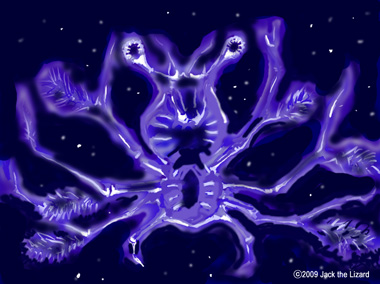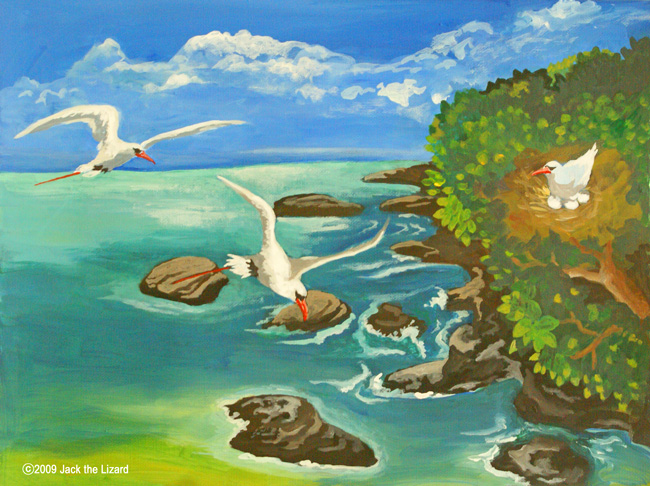
|
|
(February, 2009)
Based on "The Case of the Missing Lobsters" by Dr. Jeffrey Polovina, chief scientist of the Ecosystem and Oceanography Division at the NOAA Pacific Islands Fisheries Science Center.
|
The story of Voyage of loggerhead sea turtles with Dr. Polovina and the NOAA research team is here. This page has the external link with Western Pacific Regional Fishery Management Council. |
Show me LOBSTERS!
|
In September 1989 Dr. Polovina advised anxious lobstermen on the harvest of spiny lobster in the northwestern Hawaiian Islands. “Overfishing is obvious reason for a low catch in this season. But do not worry, it was a temporary event. Lobsters will be back next year” he said. In 1990 Lobstermen were not happy. Lobsters did not come back!! Dr. Polovina was not only embarrassed but also under pressure from frustrated fishermen. He had to find the real reason of missing lobsters. |

|
Start from birds
 Red-footed booby bird
Red-footed booby bird
|
He visited Beth Flint, seabird biologist working for U.S. fish and Wildlife Service and told her his story. Her response was not directly related to lobster, but it provided him some clues. The reproductive success of the Red-tailed tropic bird and the red–footed booby bird significantly dropped since 1985. |
Based on her story he examined the files of birds and found out the fact that the decline of seabird reproduction success preceded the decline in lobster catches by three or four years. But he wondered why there were time lag between the success rate and the lobster catch, in addition to that why the number of their prey was declined at first. He needed further information for explanation.

May be Monk Seal

|
Marine mammal expert Tim Ragen explained about first–year survival rate of Hawaiian monk seal and he also pointed out that the rate dropped from about 85% in the mid-1980s to about 45% in the early 1990s. "I cannot tell exact cause of declining, but I have sensed that the decrease of reef fishes and lobsters played role of this trend, because reef fishes and lobsters are main diets of Hawaiian monk seal." He said. Lobsters, seabirds and monk seals all of them are connected to one way or the other. Dr. Polovina suspected “Something affected entire coral reef ecosystem.” Prior to find out what it is, he needed to estimate the density of reef fishes. Ed DeMartini, a coral reef ecologist, helped him to get that information. |
Either directly or indirectly
 Phytoplankton is the microscopic plant. It floats near the ocean surface and sustains almost all life of oceanic animals at the base of the food chain. For that reason the numbers of the reef fishes depends on the quantity of phytoplankton which can be observed from space. The sensor of the satellite picks up the light reflected from the chlorophyll in the phytoplankton.
Phytoplankton is the microscopic plant. It floats near the ocean surface and sustains almost all life of oceanic animals at the base of the food chain. For that reason the numbers of the reef fishes depends on the quantity of phytoplankton which can be observed from space. The sensor of the satellite picks up the light reflected from the chlorophyll in the phytoplankton.
The result from Ed DeMartini showed that the numbers of the most species of coral reef have dropped 30 percent from what they were in the early 1980s. In the meantime Dr. Polovina found presumable suspect during the conference on climate change and northern fish population. The Aleutian low pressure system is the one.
 NOAA's research divers serveyed the density of coral reef fishes.
NOAA's research divers serveyed the density of coral reef fishes.
|
Gary Mitchum, a physical oceanographer at the University of Hawaii, who had traced the linkage between atmosphere and ocean during this period. He noticed several features of ocean. One of them was exceptionally high sea level in the central and eastern North Pacific region. Another is the extension of warm surface water. The intensity and position of the Aleutian low corresponded to both of those ocean features.  |
Wind and PlanktonIn the early 1980s the Aleutian low reached the greatest intensity ever and it brought strong west wind to northwestern Hawaii. Consequently the wind driven current and rough seas had blended deep nutrient-rich waters with nutrient-poor surface waters. Usually this mixture is not happened in midoceanic regions such as the water around Hawaii. However once this phenomenon has arisen, the growth of phytoplankton increases remarkably. Then zooplankton thrives and sustains the abundance of flying fishes and squids. Reef fishes and lobsters also increase their population because they eat planktons during their larval phase. |
 This is not an alien. This is a larva of lobster (baby lobster).
This is not an alien. This is a larva of lobster (baby lobster).
|

Red-tailed tropic bird The Northwestern Hawaiian Islands Marine National Monument is the largest fully protected area in the United States. It has a great diversity of reef environments and provides a variety of habitat to federally protected species, such as green sea turtle, seabirds, endangered land birds and several species of marine mammals. |
Although decline in the survival of lobster larvae immediately followed the diminishment of the Aleutian low in the mid-1980s, a low catch would not occurred until the very late 1980s and early 1990s because Lobstermen catch only three to four years old. Same pattern could be applied to monk seal pups, because they will only eat lobsters and reef fishes that are at least several years old. On the other hand the number of seabird chicks declined with fading low, because juvenile flying fish and squid declined in number. Thus the time lag problem is explained. |
The opposite is more likely
 He went back to the lobstermen.
He went back to the lobstermen.
The commercial lobster fishery had only been in operation since 1980, when lobsters were plentiful. After learning that abnormal climate affected ocean in the early 1980s, Dr. Polovina convinced that the opposite is more likely. As the population of lobsters returned only usual level, poor catches in the 1989 and 1990 were not unusual after all.
"I have good news and bad news. Overfishing did not cause the decline in lobster catches. That is the good news. The bad news is that, unless the Aleutian low strengthened again, lobster catches remain poor," he said.
Dr. Polovina solved the lobster mystery with help of several experts surround him. Furthermore he leaned the intricate balance between marine ecosystem and climate during this investigation.
Wildlife refuge
 The Aleutian low has not changed from the 1990s to the present. The lobster fishery in the Northwestern Hawaiian Islands has closed in 2000 and remained close since then.
The Aleutian low has not changed from the 1990s to the present. The lobster fishery in the Northwestern Hawaiian Islands has closed in 2000 and remained close since then.
Northwestern Hawaiian Islands are designated as a national marine sanctuary in December 2000 and a national marine monument in 2006. It is now being considered for World Heritage Status.